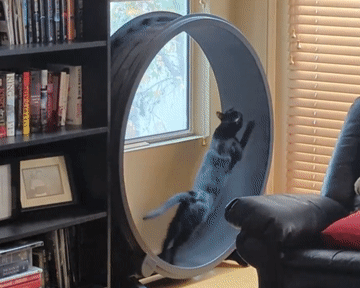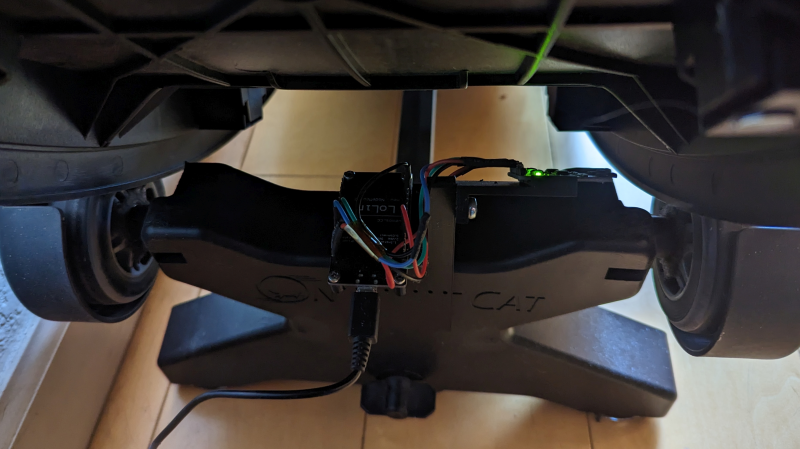[Scott Cutler] has a young cat, [Cygnus], that loves to run on a cat wheel and [Scott] had some some important questions about [Cygnus]’s usage of the cat wheel like, how often it’s used, what direction is preferred and how fast does [Cygnus] go. To answer these questions, [Scott] put some telemetry sensors onto the cat wheel and analyzed the results.
An ESP8266 microcontroller and two 3144E hall effect modules were used to sense eight magnets glued onto the outer housing of a “One Fast Cat” cat wheel. [Scott] installed the ESP8266 and hall effect modules onto the base support for the wheels, using 3D printed brackets to secure them.
 For the software side, the ESP8266 attaches an interrupt handler whenever a sensor passes by, recording a window of three previous measurements for valid sample determination and, if accepted, uses the time between samples to infer direction and speed. The ESP8266 connects to a pre-configured local WiFi network and has a telnet interface to extract stored log information, in the form of JSON data.
For the software side, the ESP8266 attaches an interrupt handler whenever a sensor passes by, recording a window of three previous measurements for valid sample determination and, if accepted, uses the time between samples to infer direction and speed. The ESP8266 connects to a pre-configured local WiFi network and has a telnet interface to extract stored log information, in the form of JSON data.
[Scott] has some nice graphs and other data visualizations on [Cygnus]’s usage, including a preference for running at 3 AM, achieving a maximum speed of 14 mph and an average of 4 seconds per run. The source is available on GitHub and the STL files are available embedded in [Scott]’s write-up. We’ve featured cat exercise trackers before with a giant hamster wheel outfitted with a Raspberry Pi and it’s nice to see some options that allow for a retrofit option in addition to a complete DIY solution.
















I don’t see how direction is determined.
If you followed the link you’d immediately see:
“Technically, I only needed a single sensor to measure the speed. But I wanted to measure the direction as well, and the sensors are cheap. The idea is simple: the two sensors are close together, while the magnets are (relatively) far apart. If the timing looks like A-B——A-B——A-B, then it is going in one direction. If the timing looks like B-A——B-A——B-A, then it is in the other direction.”
After he first mentioned “3144E Hall-effect sensors:”
Direction probably isn’t necessary anyway – my cat always runs in the same direction on the wheel.
If the wheel is in the right position, the sensor can flick backwards and forwards, causing spurious readings. Keeping track of the direction eliminates that.
I got that wheel thinking it would help my fuzzy couch potatoes get some exercise. Like the less fuzzy type, they had other ideas. I passed the wheel on for the next contestant to try out.
wondering if you can power it with the wheel itself?
I have read, that it can be bad for the spine, if a cat runs in a wheel for extended time. Does anybody know about that?
that is true if the wheel diameter is too small. The wheel shown in this video (One Fast Cat) Wheel is around 48″ so it is large enough for a domestic cat. Probably too small for a wild cat like a full serval cat.